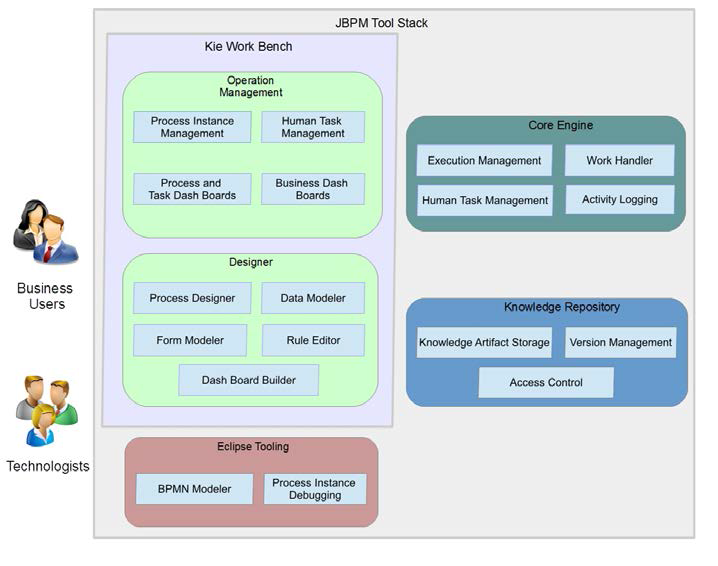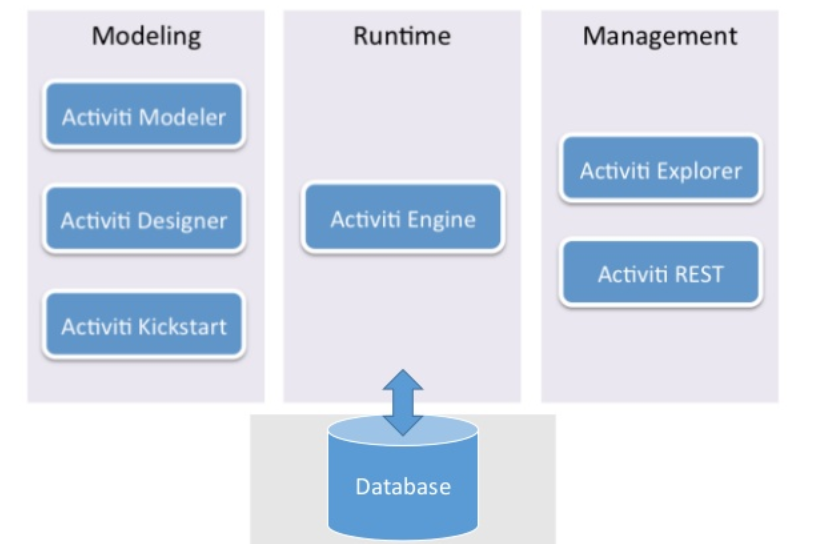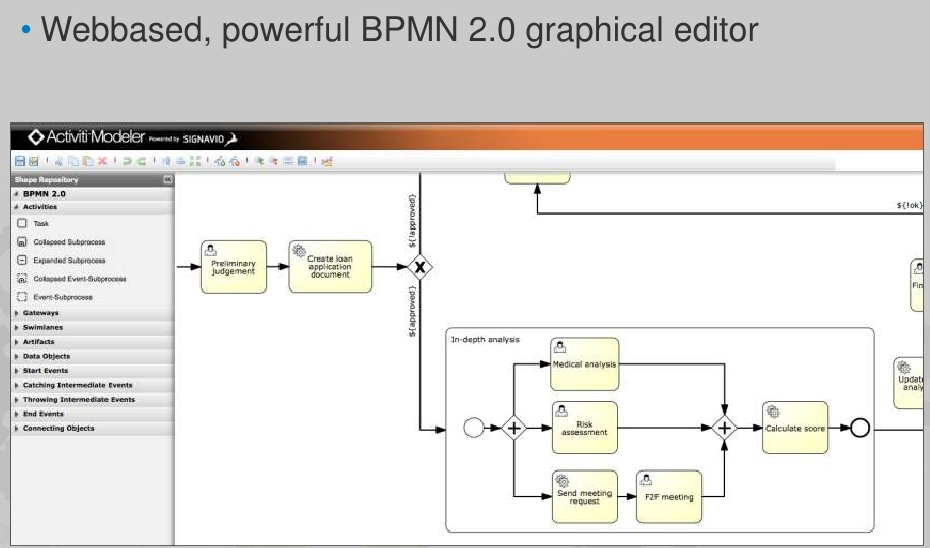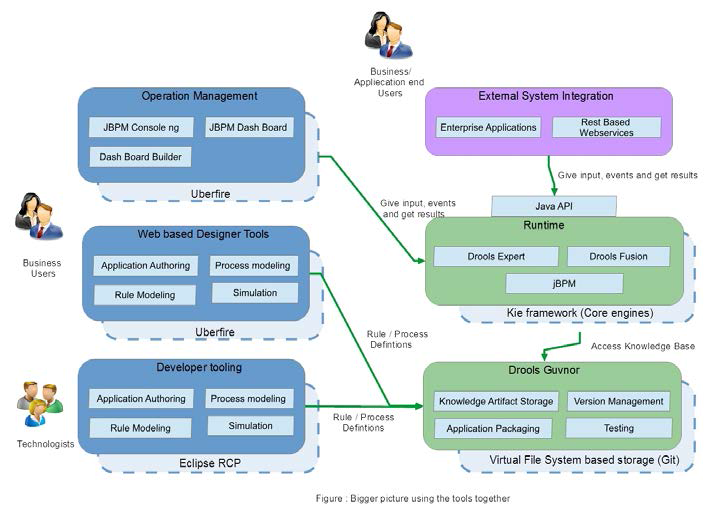最近我们有个使用了jbpm 6.2(6.2是一个较大的里程碑)的批处理模块,因为大BOSS一直觉得太重了,希望有更加轻量级的解决方案,因为我们基本上没有真正意义上流程的概念,只有静态的流程图,因为一直忙于其他事情,于是这周才正式开始研究jbpm的一些细节(前几年很多支持的项目中也接触过,不过更多的是解决一些故障类问题,本身对流程类的不感冒)。顺便研究了下jbpm。
jbpm的整体技术栈从用户层面组成如下:

activiti技术栈:

bpmn web设计器:https://bpmn.io/,集成Activiti Modeler到项目中,可以参考http://whatlookingfor.com/2016/10/11/activiti%E5%85%A5%E9%97%A8%E5%85%AD-%E9%9B%86%E6%88%90%E6%96%B0%E7%89%88Activiti-Modeler%E4%B8%8ERest%E6%9C%8D%E5%8A%A1/index.html。
http://www.kafeitu.me/activiti/2013/03/10/integrate-activiti-modeler.html
模型只要符合bpmn2规范即可,不一定要使用activiti自己的设计器进行设计。数据库可以中自己的DAO替换activiti实现,只要接口一致即可,REST也一样,可以用应用自己的管理界面。支持web基于bpmn2的流程设计器。

jbpm的整体技术栈从实现层面组成如下:

在实际应用中,几乎很少有直接使用jbpm kb的,一般都是集成到ERP或者portal中,不过是整合深入的问题,整合深入的可能只需要设计工具得到bpmn流程图以及通过api调用运行时的一些功能。整合不深的可能就流程的流转直接依赖于jbpm提供的整套方案。
jbpm 6 vs activities 5(不过activities是jbpm之后创始人分道扬镳新搞的,这个很早就知道了,跟mysql和mariadb一样):
- Embeddable, lightweight Java process engine, supporting native BPMN 2.0 execution
- human interaction using an independent WS-HT task service
- BPMN 2.0 process modeling in Eclipse (developers) and the web (business users)
- web tooling to model, deploy, execute and monitor your processes, including for example a data and form modeler, simulation, deployment, task lists, etc.
- web-based business activity monitoring and reporting that allows you to define your own reports
- managing and deploying your processes using technologies underneath like Git and Maven
- an execution server that you can remotely connect to (REST, JMS) and can be deployed in a clustered environment for load balancing and high availability
- tight, powerful integration with business rules and event processing
- Allows user updates to be combined with process updates in a single transaction
- Runs on any Java environment like Spring, JTA, standalone with any form of transaction demarcation.
- Easy to get up and running with the setup utility
- Built to support the cloud scalability from the ground up
- Very simple to add new custom activity types and complete dedicated process languages
- Rock solid
- Extremely fast
- Transactional timers
- Asynchronous continuations
- Hidden event listeners for decoupling software technical details from business level diagram
- Ability to test process executions in isolation in a plain unit test
|
Description
|
Activiti
|
jBPM
|
|
Community members
|
Activiti has a base team consisting of
Alfresco employees. In addition,
companies like SpringSource,
FuseSource and MuleSoft provide
resources on specific components. And of course, there are individual open source developers committing to the Activiti project.
|
jBPM has a base team of JBoss
employees. In addition there are individual committers.
|
|
Spring support
|
Activiti has native Spring support, which makes it very easy use Spring beans in your processes and use Spring for JPA and transaction management.
|
jBPM has no native Spring
support, but you can use Spring
with additional development effort.
|
|
Business rules support
|
Activiti provides a basic integration with the Drools rule engine to support the BPMN 2.0 business rule task.
|
jBPM and Drools are integrated on a project level and therefore there’s native integration with Drools on various levels.
|
|
Additional tools
|
Activiti provides a modeler (Oryx) and designer (Eclipse) tool to model new process definitions. But the main differentiator is the Activiti Explorer, which provides an easy-to-use web interface to start new processes, work with tasks and forms and manage the running processes. In addition it provides ad-hoc task support and collaboration functionality.
|
jBPM also provides a modeler
based on the Oryx project and a Eclipse designer. With a web
application you can start new
process instances and work with tasks. The form support is
limited
|
|
Project
|
Activiti has a strong developer and user community with a solid release schedule of 2 months. Its main components are the Engine, Designer, Explorer and REST application
|
jBPM has a strong developer and user community. The release schedule is not crystal clear and some releases have been postponed a couple of times. The Designer application is (at the moment of writing) still based on Drools Flow and the promised new Eclipse plug-in keeps getting postponed
|
其他特性还没有仔细研究,后面会把我们实际用到的表使用以及重要性都梳理出来并更新(后续剥离敏感信息后发上来,也可以私信留言)。
最近继续研究bpm相关的框架,在搜索jbpm 6和activities 5对比的时候,偶然发现2年前,jbpm的原创始团队又另立门户了,搞了个Flowable 6.0出来,参考:https://blog.youkuaiyun.com/hj7jay/article/details/68483096。这些坑大了,还是选择jbpm吧,起码后面的金主redhat为持续支持。
下面摘录一份不恰当(不恰当是因为jbpm 5是被Jboss废弃的版本)的jbpm 5和activities 5的对比:Activiti5与jBPM5技术组成对比
| 序号 | 技术组成 | Activiti | jBPM5 |
| 1 | 数据库持久层ORM | MyBatis3 | Hibernate3 |
| 2 | 持久化标准 | 无 | JPA规范 |
| 3 | 事务管理 | MyBatis机制/Spring事务控制 | Bitronix,基于JTA事务管理 |
| 4 | 数据库连接方式 | Jdbc/DataSource | Jdbc/DataSource |
| 5 | 支持数据库 | Oracle、SQL Server、MySQL等多数数据库 | Oracle、SQL Server、MySQL等多数数据库 |
| 6 | 设计模式 | Command模式、观察者模式等 | |
| 7 | 内部服务通讯 | Service间通过API调用 | 基于Apache Mina异步通讯 |
| 8 | 集成接口 | SOAP、Mule、RESTful | 消息通讯 |
| 9 | 支持的流程格式 | BPMN2、xPDL、jPDL等 | 目前仅只支持BPMN2 xml |
| 10 | 引擎核心 | PVM(流程虚拟机) | Drools |
| 11 | 技术前身 | jBPM3、jBPM4 | Drools Flow |
| 12 | 所属公司 | Alfresco | jBoss.org |
国外还有一家自称比jbpm 6 NB的工作流厂商,Camunda BPM 7,可以参考下。
 jbpm技术栈及与其他框架对比研究
jbpm技术栈及与其他框架对比研究







 博客围绕jbpm展开,因大BOSS希望有轻量级解决方案,作者开始研究jbpm细节。介绍了jbpm从用户和实现层面的技术栈组成,对比了jbpm 6与activities 5的特点,还提及发现jbpm原创始团队推出Flowable 6.0,最后提到国外自称更优的工作流厂商Camunda BPM 7。
博客围绕jbpm展开,因大BOSS希望有轻量级解决方案,作者开始研究jbpm细节。介绍了jbpm从用户和实现层面的技术栈组成,对比了jbpm 6与activities 5的特点,还提及发现jbpm原创始团队推出Flowable 6.0,最后提到国外自称更优的工作流厂商Camunda BPM 7。


















 被折叠的 条评论
为什么被折叠?
被折叠的 条评论
为什么被折叠?








